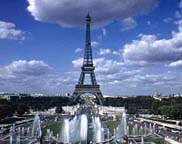![]()
![]()
![]()
![]()
![]()
![]()
![]()
![]()

![]()
![]()
Paris History and FactsParis, the capital of France, is located in northern France on both banks of the Seine River, 145 km (90 mi) from the river's mouth on the English Channel. A total of 2,135,300 (2002) inhabitants live in Paris proper, and almost 11 million persons (1999) live in greater Paris (the Ile-de-France region), which is one of Europe's largest metropolitan areas. A city of world importance and the business, historic, intellectual, diplomatic, religious, educational, artistic, and tourist center of France, Paris owes its prosperity in large part to its favorable position on the Seine, which has been a major commercial artery since the Roman period. Climate
The climate is characterized by a lack of extremes, with an average temperature of 19 degrees C (66 degrees F) in July and 3 degrees C (37 degrees F) in January. The 585 mm (23 in) of precipitation is well distributed throughout the year, often in the form of a soft drizzle. EconomyParis has been one of the major cities of Europe since the Middle Ages, but the development of the city as it exists today occurred in the second half of the 19th century. Its greatest growth came during a 40-year period after 1850, when the population doubled in size to more than 2 million; it reached a peak in 1921 (2,906,500), after which people began migrating away from the city. Since then, as homes have been replaced by offices in Paris proper, most of the growth has occurred in the suburbs, where a large portion of the blue-collar work force lives. Of a total of 2 million commuters, about half travel daily from the outlying areas to the city center, and half travel from central Paris to the suburbs. The economic activities of Paris overshadow those of any other part of France in importance and complexity. About 65 percent of the nation's bank and corporate headquarters are in the city. Much of the industry in central Paris is of the small-scale craft type, based on skill and most often family owned. Many of these industries make luxury items such as perfumes, furs, gloves, jewelry, toys, clothing, wooden articles, and other high-value goods. Book printing and publishing are major activities in central Paris. Heavier industries are situated in the suburbs. These include the manufacture of automobiles, machine tools, railroad rolling stock, electric and electronic products, chemicals, and processed foods. Construction and the production of building materials are also important. Tourism, however, is by far the city's largest source of income; it is one of Europe's leading tourist attractions. Government
Paris is divided into 20 unequally sized arrondissements, or districts, each with its own mayor. Each of these is again divided into four sections. Two prefects and a mayor administer the city as a whole with the assistance of a general council. "Paris is the
greatest temple ever built to TransportationParis is the head of barge and ship navigation on the Seine and is the fourth most important port in France (after Marseille, Le Havre, and Dunkerque). The Loire, Rhine, Rhône, Meuse, and Scheldt rivers can be reached by canals connecting with the Seine, and a large amount of the imports and exports of the city are transported via water. Total freight carried to and from the port annually amounts to 43 million U.S. tons. Paris is also a major rail, highway, and air transportation hub. Two international airports, Orly and Charles de Gaulle, as well as Le Bourget (for domestic flights), serve the city. De Gaulle ranks as the fifth busiest international airport in the world and Orly as the seventh. The city's subway system, the Métro, was opened on July 19, 1900, its first line being from Porte de Vincennes to Porte Maillot. Engineer Fulgence Bienvenüe oversaw the construction phase, while architect Hector Guimard designed the decorative Art Nouveau entrances. The system boasts 199 km (124 miles) of track and 15 lines. There are 368 stations (not including RER stations), 87 of these being interchanges between lines. A total of 3500 cars transport roughly 6 million people per day, while the system itself employs 15,000 employees (1989 statistics). Every building in Paris is within 500 meters (3/10 mile) of a métro station. The Réseau Express Régional (RER), inaugurated in the 1960s, connects the city with its outlying suburbs. "The last
time I see Paris will be on the day I die. |
![]()
![]()
© Copyright 2026 Hotels
of Paris. All rights reserved. Unauthorized duplication in part or whole
prohibited.
![]()








